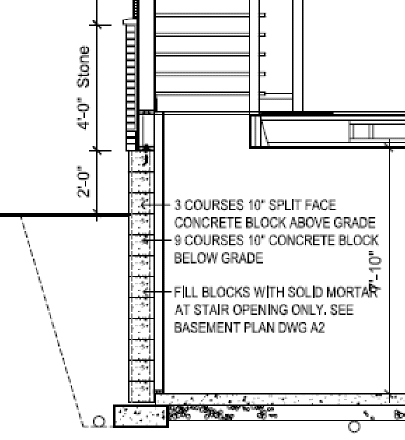Footings
The minimum depth of a footing is usually determined by the
anticipated depth that frost will penetrate below the soil. This
depth is determined by using the building code that is applicable
for your area. In Canada, the Provinces have adopted building codes
that provide climactic conditions including the required depth below
soil for footings.

The Ontario Building Code uses an assumed value of 1500 psf (75
KPa) for the bearing capacity of soils. A soils test can be
carried out to determine the actual bearing capacity of the soil.
The information derived from this test will provide you with the
bearing capacity for the soil on your site.
How does the soil's bearing capacity relate to the size of the
footings? Lets say that you have a soils report in hand that says
the bearing capacity of the soil is 3000 psf. That's the number to
start with. From there, you need to work backwards and figure out
the loads acting on the footing in pounds per lineal foot (or
KiloNewtons per lineal metre KN/m) - plf or KN/m
The footing of a building transmits load to the soil. The lower
the bearing capacity of the soil, the wider the footing needs to be.
If the soil is firm, the footing can be narrower. Consider some of
the following numbers. Sand has a bearing capacity of about 3000 psf
(pounds per square foot). This means for instance that a 12 inch
wide footing will be able to sustain loading of 3000 plf (pounds per
linear foot). Footing calculations are a good example of calculating
what is otherwise known as a load path - meaning all of the loads
above that are acting on the footing from the roof down. Try a
calculation for a typical 2 storey house using common loading
conditions to see what this looks like. To do this, you will need to calculate the live loads and the dead loads.
After this, you will calculate the length of supported floors that
the footings will support. Then you calculate the wall loads and
that generally will suffice to contemplate an approximate footing
size for your project.
Live loads on
roof
20 psf x 1.5 = 30.00 psf
Dead Loads on Roof 15 psf x 1.25 =
18.75 psf
Live Loads on Floor 40 psf
x 1.5 = 50.00 psf
Dead loads from floor 12 psf x 1.25 =
18.00 psf
The loading
indicated above will vary for the roof loads depending on where you live and how
much snow you get. In Toronto, the value is 20 psf so we will use this for the
calculations. The live loads from floors are the same across Canada being 40
psf. The dead loads are derived based upon the anticipated flooring material. If
you are using tile or hardwood flooring on subfloor with wood joists, the dead
load value will be around 12 to 15 psf. If you are using a concrete underlay,
the value will be around 20 psf. We will use the typical 12 psf for these
calculations.
Then you
wonder, why the 'x1.5' and the 'x1.25'? These are the values that are used to
factor the live and dead load values. When calculating the loading requirements
for floor joists and beams, you need to use the factored loads. When calculating
for footing size, you use the specified loads only.